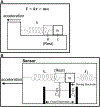Accelerometry applications and methods to assess standing balance in older adults and mobility-limited patient populations: a narrative review
- PMID: 37526887
- PMCID: PMC10881067
- DOI: 10.1007/s40520-023-02503-x
Accelerometry applications and methods to assess standing balance in older adults and mobility-limited patient populations: a narrative review
Abstract
Accelerometers provide an opportunity to expand standing balance assessments outside of the laboratory. The purpose of this narrative review is to show that accelerometers are accurate, objective, and accessible tools for balance assessment. Accelerometry has been validated against current gold standard technology, such as optical motion capture systems and force plates. Many studies have been conducted to show how accelerometers can be useful for clinical examinations. Recent studies have begun to apply classification algorithms to accelerometry balance measures to discriminate populations at risk for falls. In addition to healthy older adults, accelerometry can monitor balance in patient populations such as Parkinson's disease, multiple sclerosis, and traumatic brain injury. The lack of software packages or easy-to-use applications have hindered the shift into the clinical space. Lack of consensus on outcome metrics has also slowed the clinical adoption of accelerometer-based balance assessments. Future studies should focus on metrics that are most helpful to evaluate balance in specific populations and protocols that are clinically efficacious.
Keywords: Accelerometry; Accessibility; Balance; Fall risk.
© 2023. The Author(s), under exclusive licence to Springer Nature Switzerland AG.
Conflict of interest statement
The authors declare no conflicts of interest.
Figures


Similar articles
-
Metrics extracted from a single wearable sensor during sit-stand transitions relate to mobility impairment and fall risk in people with multiple sclerosis.Gait Posture. 2020 Jul;80:361-366. doi: 10.1016/j.gaitpost.2020.06.014. Epub 2020 Jun 20. Gait Posture. 2020. PMID: 32615409 Free PMC article.
-
Smartphone technology can measure postural stability and discriminate fall risk in older adults.Gait Posture. 2019 Jan;67:160-165. doi: 10.1016/j.gaitpost.2018.10.005. Epub 2018 Oct 9. Gait Posture. 2019. PMID: 30340129
-
Analyzing the Use of Accelerometers as a Method of Early Diagnosis of Alterations in Balance in Elderly People: A Systematic Review.Sensors (Basel). 2019 Sep 9;19(18):3883. doi: 10.3390/s19183883. Sensors (Basel). 2019. PMID: 31505828 Free PMC article.
-
Are Accelerometer-based Functional Outcome Assessments Feasible and Valid After Treatment for Lower Extremity Sarcomas?Clin Orthop Relat Res. 2020 Mar;478(3):482-503. doi: 10.1097/CORR.0000000000000883. Clin Orthop Relat Res. 2020. PMID: 31390339 Free PMC article.
-
Use of accelerometry to investigate standing and dynamic body balance in people with cerebral palsy: A systematic review.Gait Posture. 2022 Jul;96:357-364. doi: 10.1016/j.gaitpost.2022.06.017. Epub 2022 Jul 7. Gait Posture. 2022. PMID: 35820240
Cited by
-
Identifying Subtle Motor Deficits Before Parkinson's Disease is Diagnosed: What to Look for?J Parkinsons Dis. 2024;14(s2):S287-S296. doi: 10.3233/JPD-230350. J Parkinsons Dis. 2024. PMID: 38363620 Free PMC article. Review.
-
Remote monitoring in older adults with cancer, opportunities and challenges: a narrative review.Aging Clin Exp Res. 2025 Aug 20;37(1):249. doi: 10.1007/s40520-025-03161-x. Aging Clin Exp Res. 2025. PMID: 40833675 Free PMC article. Review.
-
Evaluating Postural Sway in the Elderly Using Inertial Measurement Units: A Study on Center of Mass Measurements via Accelerometers and Gyroscopes.J Clin Med Res. 2025 Apr;17(4):200-207. doi: 10.14740/jocmr6184. Epub 2025 Apr 11. J Clin Med Res. 2025. PMID: 40322722 Free PMC article.
-
Age-Related Dysfunction in Balance: A Comprehensive Review of Causes, Consequences, and Interventions.Aging Dis. 2024 Jan 24;16(2):714-737. doi: 10.14336/AD.2024.0124-1. Aging Dis. 2024. PMID: 38607735 Free PMC article. Review.
References
-
- Abe Y, Sugaya T, & Sakamoto M (2014). Postural control characteristics during single leg standing of individuals with a history of ankle sprain: Measurements obtained using a gravicorder and head and foot accelerometry. Journal of Physical Therapy Science, 26(3), 447–450. 10.1589/jpts.26.447 - DOI - PMC - PubMed
Publication types
MeSH terms
Grants and funding
LinkOut - more resources
Full Text Sources

